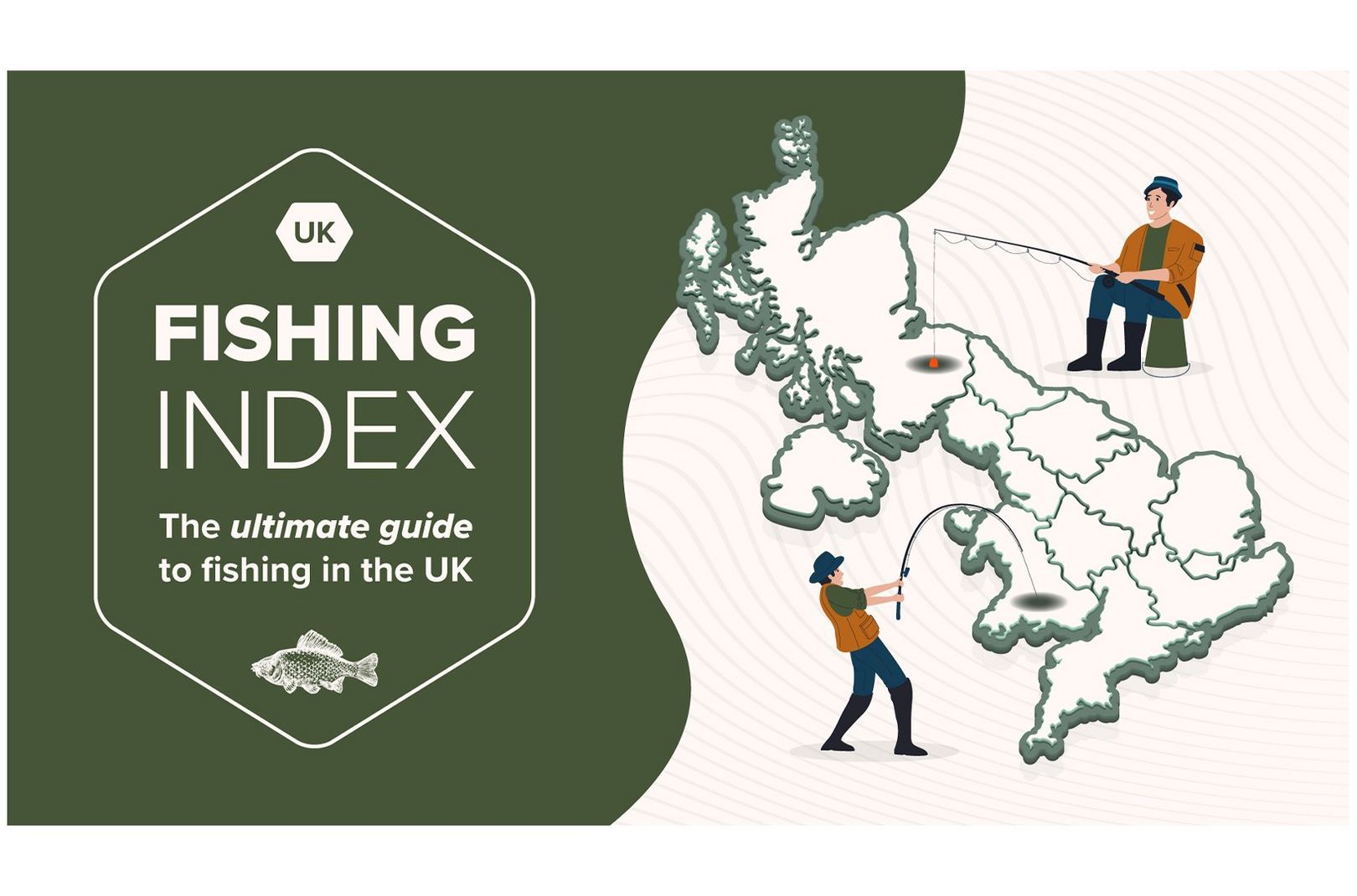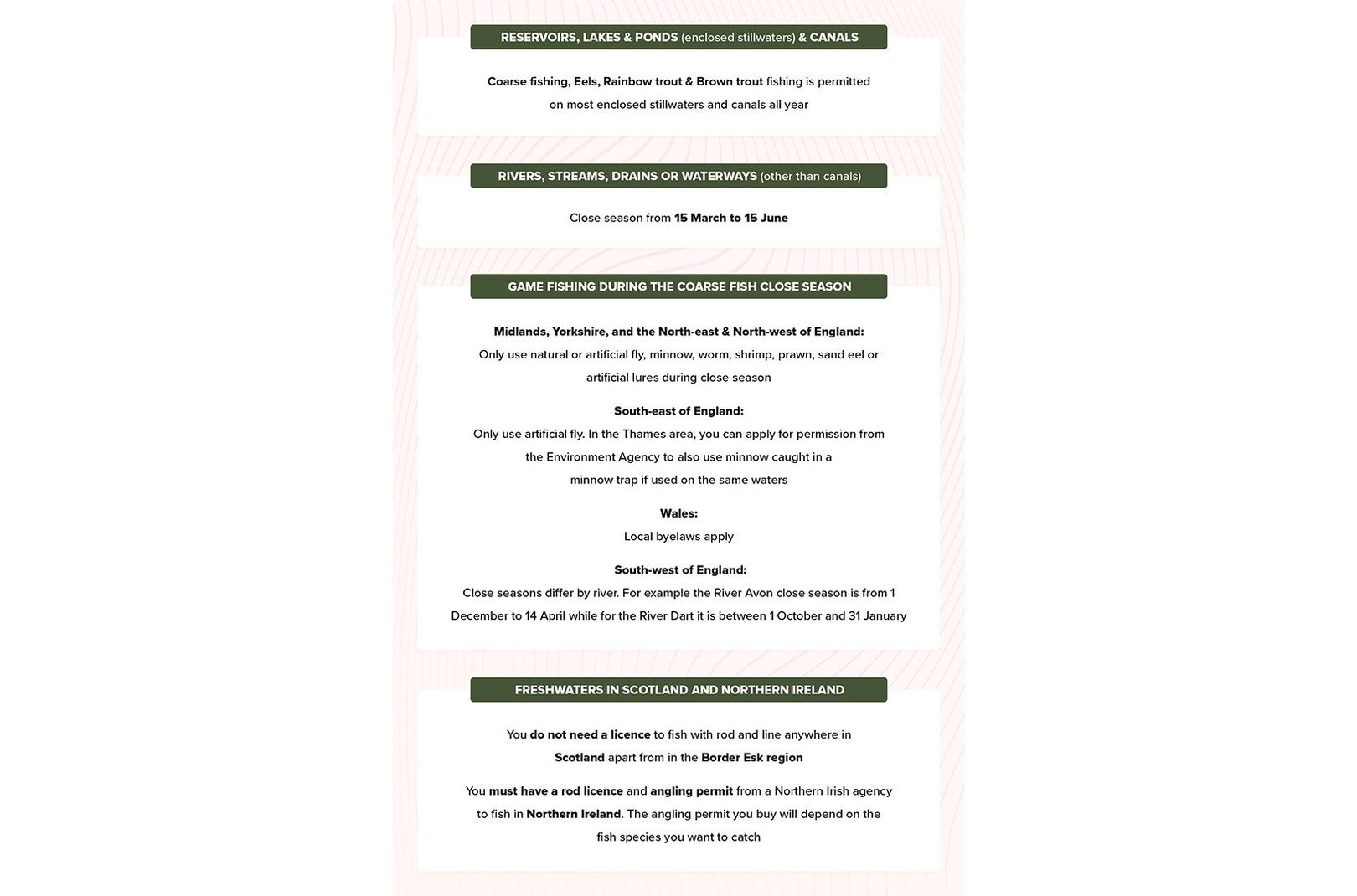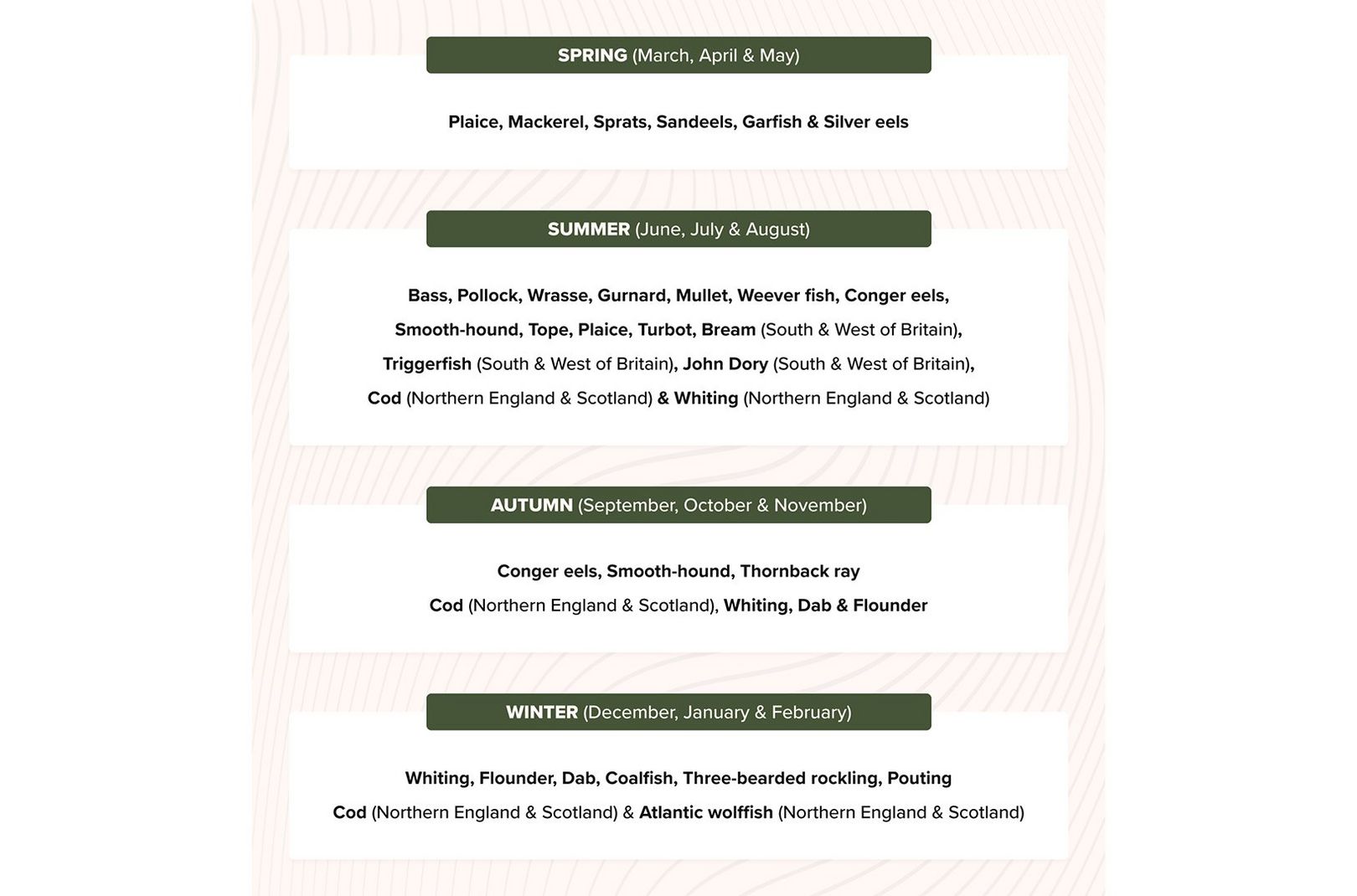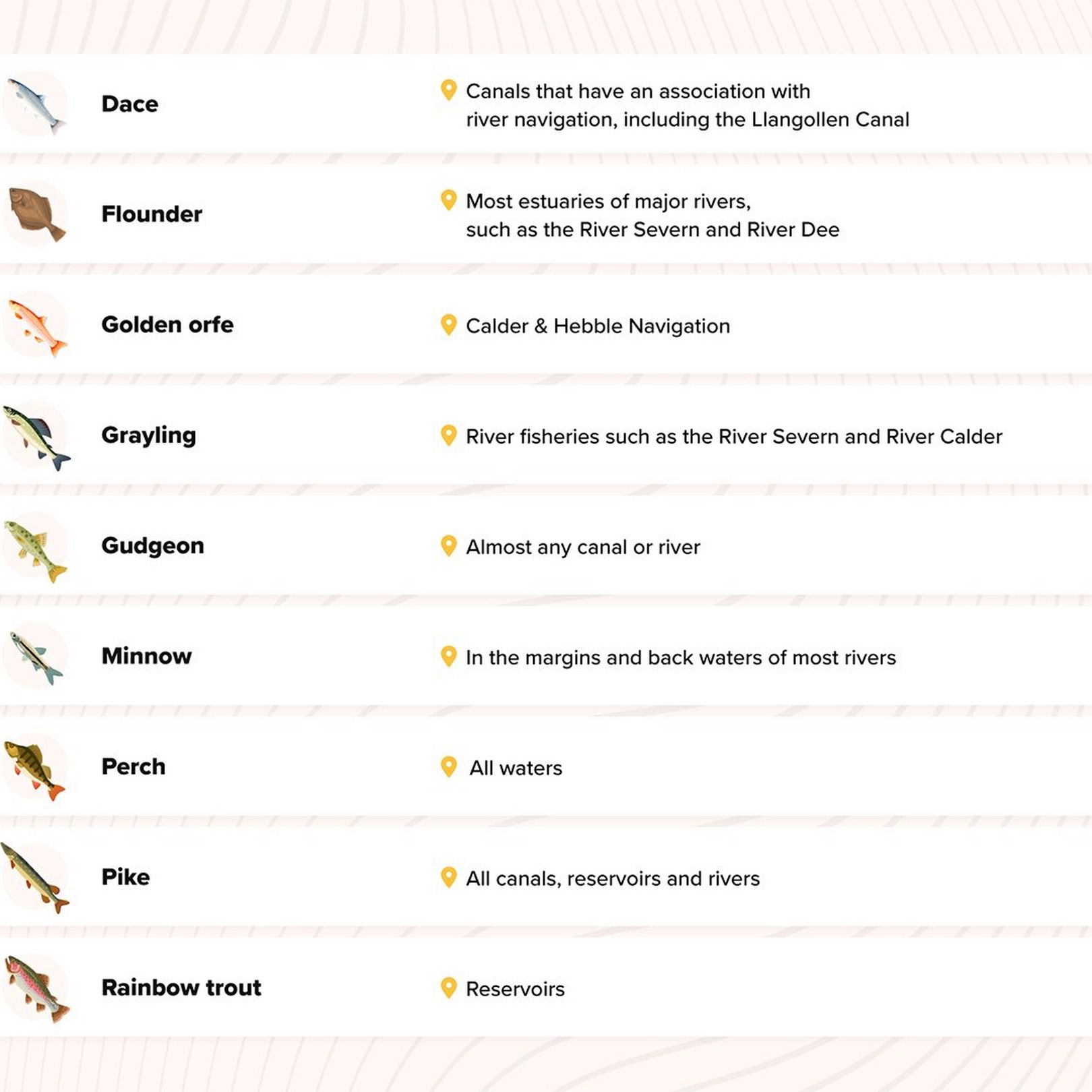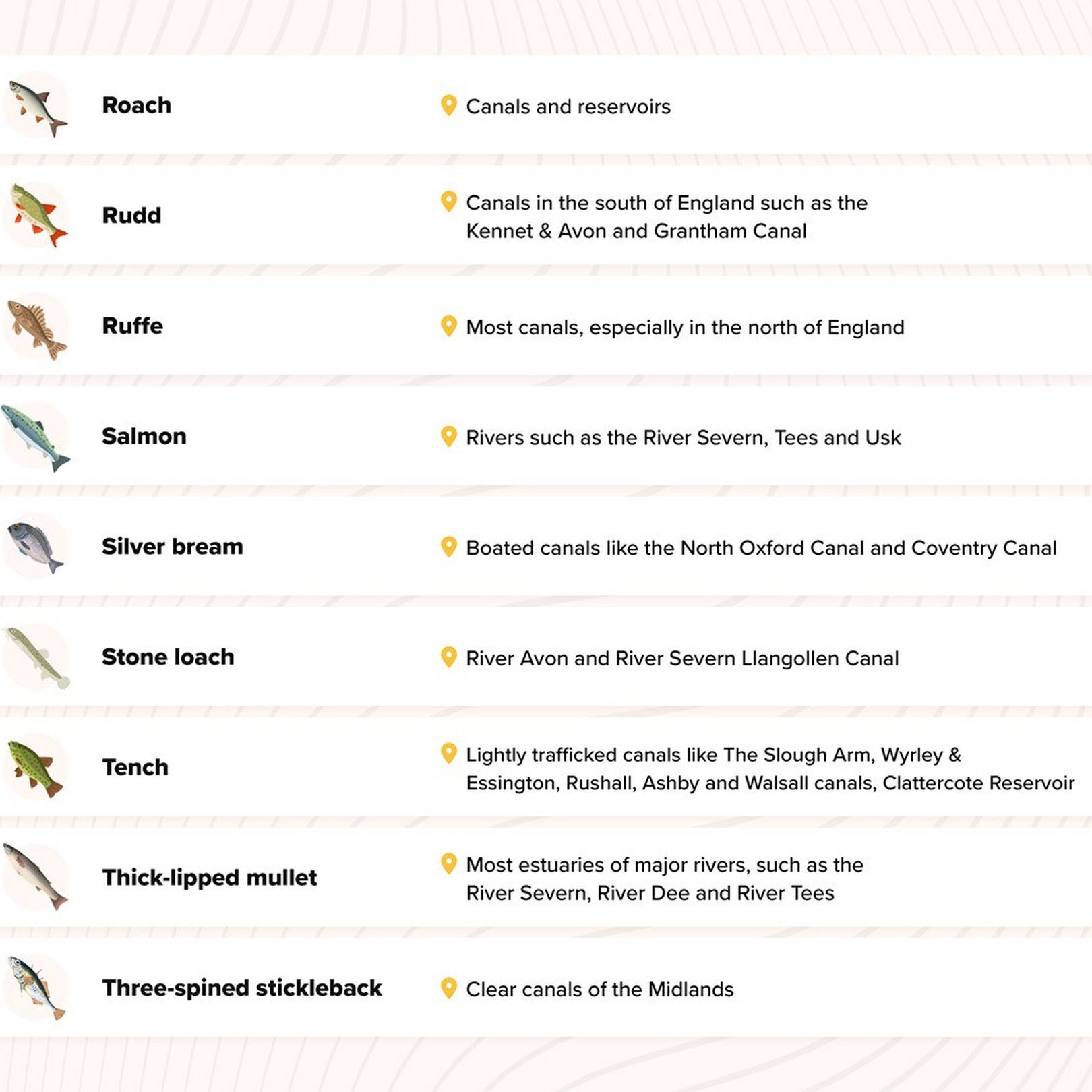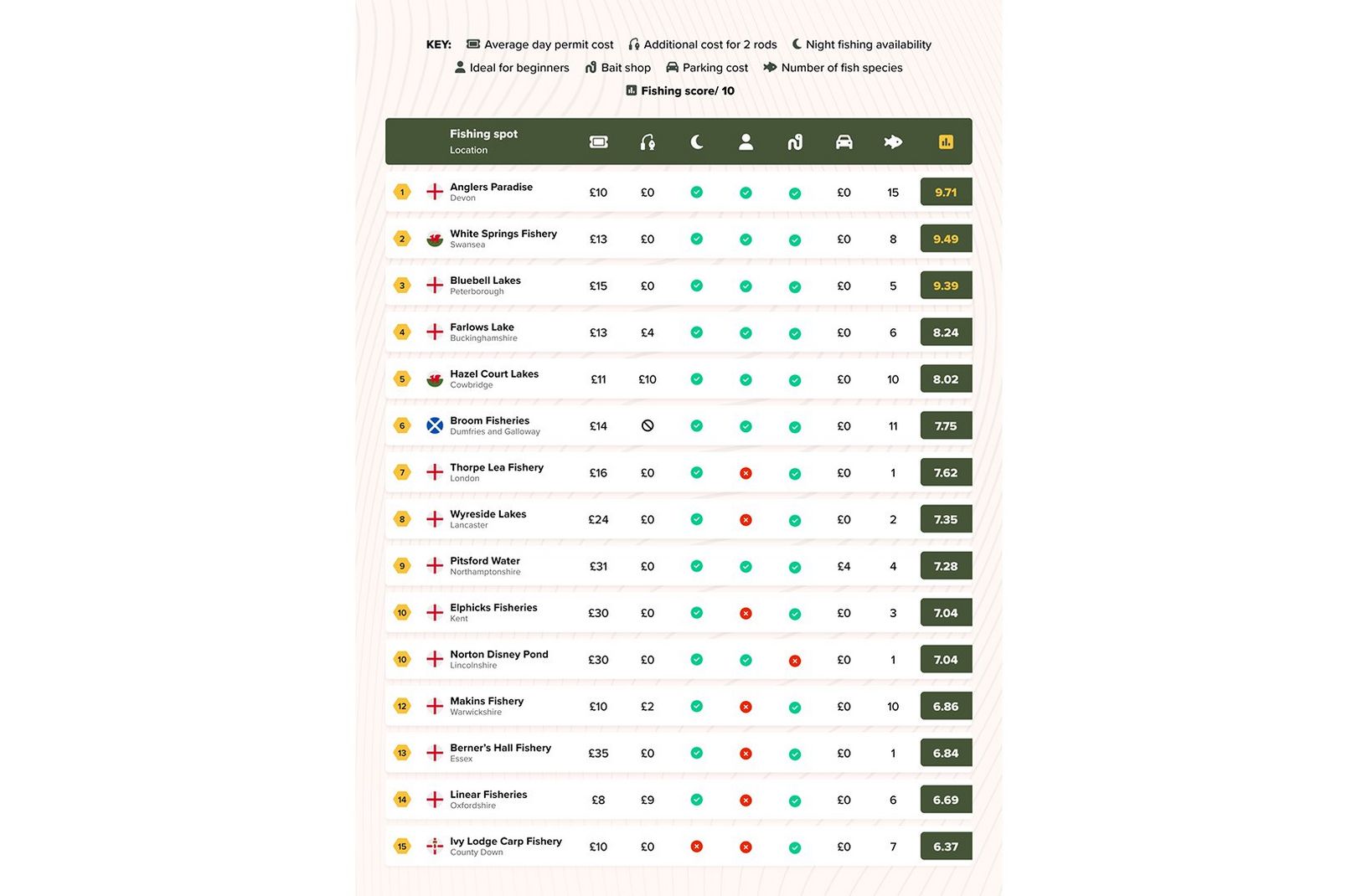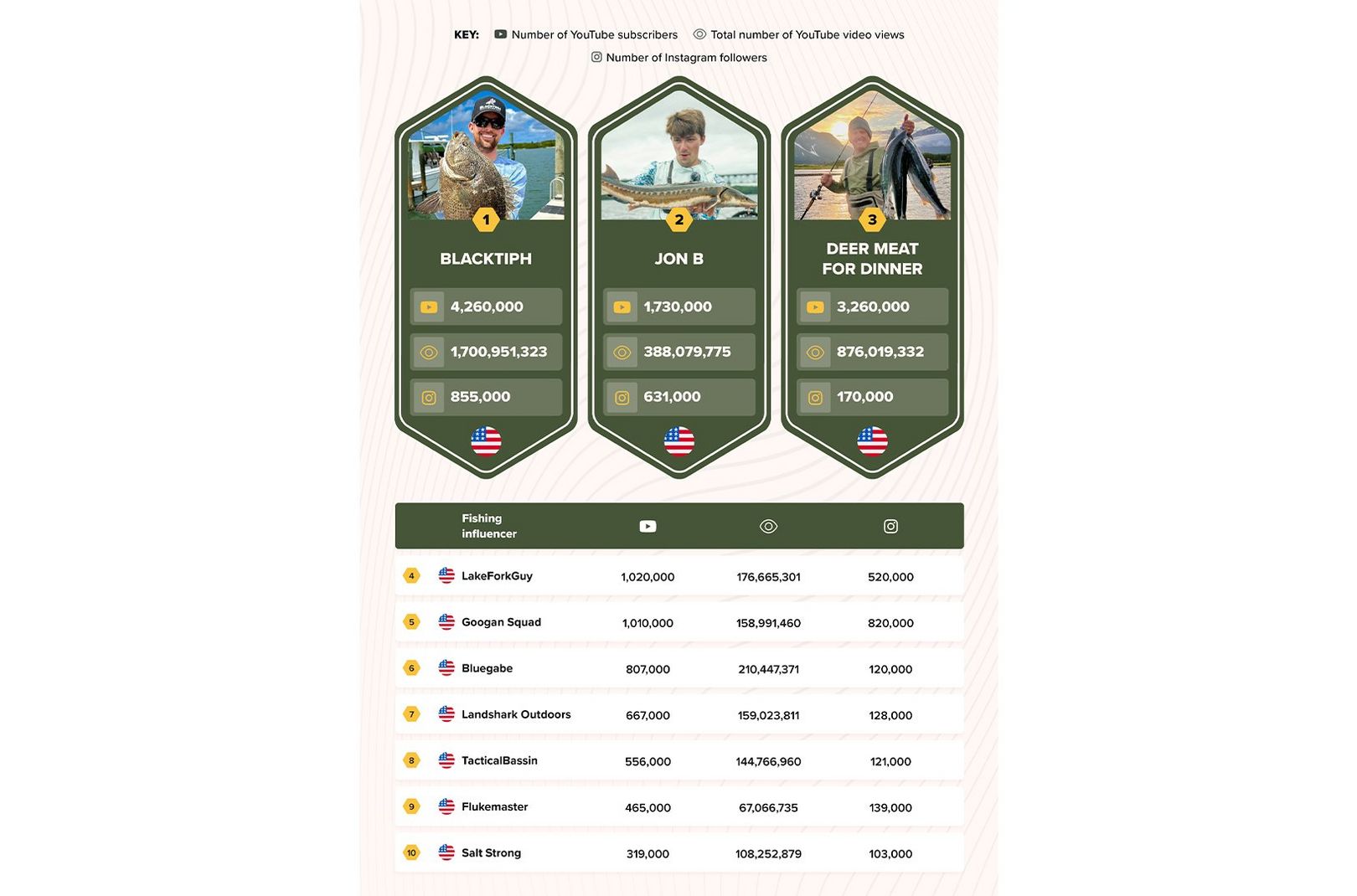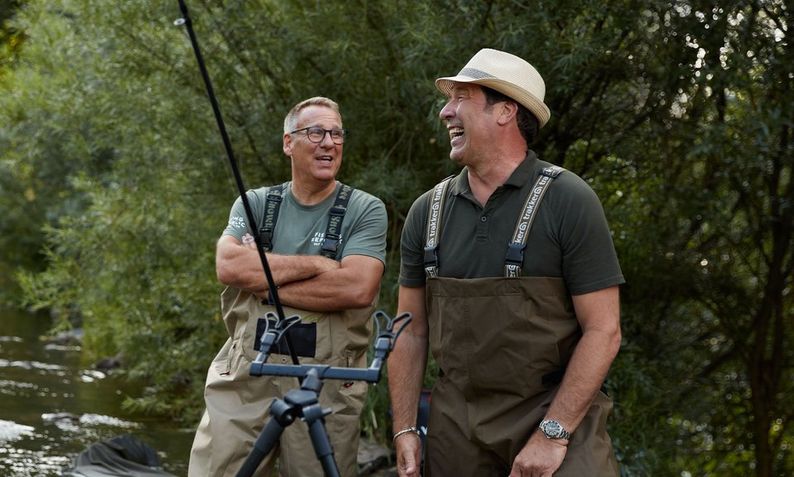The Ultimate guide to Fishing in the UK
Fishing might seem complicated to beginner anglers, but it doesn’t have to be. With just a rod, a licence, and some patience you can head to your local river, canal, lake or pond and start fishing in no time.
It’s no wonder that thousands of Brits spend their free time angling - fishing is the perfect way to escape from the hustle and bustle and spend time relaxing in the great outdoors. It’s also cheaper than you might expect to start fishing, with minimal equipment and prior knowledge needed.
This guide covers everything you need to know before you get out fishing for the first time, from the essential fishing tackle to the best destinations to cast in the UK. We’ll also look at the best fishing influencers to follow for tips and inspiration.
The Best Times to go Fishing in the UK
Sea fishing and what to catch
If you are fishing in the sea, you do not need a fishing licence. You should, however, always research and respect the environment where you are fishing.
Spring (March, April, May):
Anglers, sea fishing in spring can expect to catch plaice, mackerel, sprats, sand eels, garfish and silver eels.
Summer (June, July, August):
In summer, sea fishers can find bass, pollock, wrasse, gurnard, mullet, weever fish, conger eels, smooth-hound, tope, plaice, and turbot. In the South and West of the UK, anglers are likely to find bream, triggerfish, and John Dory. In the North, you are more likely to catch cod and whiting.
Winter (December, January and February):
When sea fishing in winter, you can expect to catch whiting, flounder, dab, coalfish, three-bearded rockling, and pouting. In Northern England and Scotland, you might also find cod and Atlantic wolffish.
Freshwater fish and what to catch
Reservoirs, lakes, ponds and canals
Enclosed still waters are ideal for coarse fishing. Angling for eels, rainbow trout, and brown trout is permitted on most enclosed still waters and canals all year round in the UK
Rivers and streams
These waters cannot be fished during the close season, which runs from 15th March to 15th June inclusive, each year.
Game fishing during the coarse fish close season
Midlands, Yorkshire, and the North East and North West of England
Anglers may only use natural or artificial fly, minnow, worm, shrimp, prawn, sand eel or artificial lures during the close season.
South-east of England
Anglers may only use artificial flies. In the Thames area, you can apply for permission from the Environment Agency to use a minnow.
Wales
Check your local bylaws to determine which waters can be fished.
South-west of England
Close seasons differ by river. For example, the River Avon close season is from 1st December to 14th April, while for the River Dart, it is between 1st October and 31st January.
Freshwaters in Scotland
You do not need a licence to fish with rod and line anywhere in Scotland apart from in the Border Esk region, which borders Northern England. Privately owned fishing locations may require the purchase of a permit or season membership.
Freshwaters in Northern Ireland
You must have a rod licence and angling permit from a Northern Irish agency to fish anywhere in Northern Ireland. The angling permit you buy will depend on the fish species you want to catch. For private fisheries, you must purchase a separate permit from a Northern Irish agency.
Where to catch different types of fish
- Catfish: An invasive species that can be found at Marsworth Reservoir
- Zander: An invasive species that can be found at Oxford Canal and Ashby Canal, among other locations.
- Crucian carp: An invasive species that can be found in lightly boated canals and most commercial stillwaters.
- Barbel: This species can be found in the River Severn, River Trent, and Kennet & Avon Canal, as well as most other UK rivers.
- Bleak: This species can be found in most UK rivers.
- Bream: This species can be found in the Shropshire Union, Kennet & Avon, Grand Union and Oxford Canals and most large open waters like reservoirs.
- Brown trout: This species can be found in the River Severn, River Trent, Huddersfield Narrow, Montgomery, Swansea and Llangollen canals.
- Carp: This species can be found in the Grand Union, Oxford, Kennet & Avon and Stratford canals. You can also catch carp at private fishing lakes and ponds.
- Chub: This species can be found in midlands canals, including the Staffordshire & Worcestershire Canal and Shropshire Union Canal.
- Dace: This species can be found in canals that have an association with river navigation, such as the Llangollen Canal.
- Flounder: This species can be found in most estuaries of major rivers, like the River Severn and River Dee.
- Golden orfe: This species can be found in the Calder & Hebble Navigation.
- Grayling: This species can be found in river fisheries such as the River Severn and River Calder.
- Gudgeon: This species can be found in almost any UK canal or river.
- Minnow: This species can be found in the margins and backwaters of most rivers.
- Perch: This species can be found in all UK waters.
- Pike: This species can be found in all canals, reservoirs and rivers.
- Rainbow trout: This species can be found in UK reservoirs.
- Roach: This species can be found in canals and reservoirs.
- Rudd: This species can be found in canals in the South of England, such as the Kennet & Avon and Grantham Canal.
- Ruffe: This species can be found in most canals, especially in the North of England.
- Salmon: This species can be found in rivers such as the River Severn, Tees and Usk.
- Silver bream: This species can be found in boated canals like the North Oxford Canal and Coventry Canal.
- Stone loach: This species can be found in the River Avon and River Severn Llangollen Canal.
- Tench: This species can be found in lightly boated canals like The Slough Arm, Wyrley & Essington, Rushall, Ashby and Walsall canals, and Clattercote Reservoir.
- Thick-lipped mullet: This species can be found in most estuaries of major rivers, such as the River Severn, River Dee and River Tees.
- Three-spined stickleback: This species can be found in clear canals of the Midlands.
The best fishing locations in the UK
1. Anglers Paradise - Devon, England | Fishing score: 9.71/10
The aptly named Anglers Paradise is the UK’s best day fishing destination. While most of the lakes at Anglers Paradise are reserved for residents of the villas, there are four main lakes open to all: Nirvana Lakes, Eldorado Lakes, Anglers Shangri La and Valhalla. Keen anglers can catch up to 15 fish species, including specimen carp, pike, and koi.
There is free parking for lake users, and a day permit costs £10 on average. Anglers are permitted to use a second rod for no additional charge, and there is a bait shop on-site for restocking. Anglers Paradise is home to beginner lakes, including Silver Rose Lake, where anglers can fish through the night.
2. White Springs Fishery - Swansea, Wales | Fishing score: 9.49/10
White Springs Fishery near Swansea is a popular fishing spot for Welsh anglers, home to five lakes and eight fish species, including carp, tench and chub. Day visitors can park for free and can fish any lake using a day permit, which can be purchased for £13 on average.
Anglers are permitted to use up to two rods when fishing in New Canal Lake, Pleasure Lake, and Big Pit Lake and a third rod can be used at Specimen Lake, all for no additional cost. White Springs Fishery has a bait shop and three beginner-friendly lakes, including Pleasure Lake. Non-members can also fish at night at the location by purchasing a 24-hour permit.
3. Bluebell Lakes - Peterborough, England | Fishing score: 9.39/10
Bluebell Lakes is a carp fishery, just a short drive from Oundle in Peterborough. The five lakes are home to five fish species, including carp up to 59 lbs, tench, and bream. Anglers can use the lake car park for free and purchase a day permit at the reception for £15 on average.
Day fishers can use up to three rods per peg for no additional cost at the lakes. There is also a bait shop on-site - useful for anglers who bring maggots or barbed hooks since these are not permitted for use. Bluebell Lakes is an excellent destination for less experienced anglers, with Bluebell Lake recommended for use by beginners. There is also the option to fish through the night by purchasing a 24-hour or night permit.
The most Instagrammable places you can fish
1. Loch Lomond - The Trossachs, Scotland | Number of Instagram posts: 557,046
Loch Lomond, in Loch Lomond and the Trossachs National Park, is the most picturesque spot in the UK where anglers can fish for the day. While fishing here is recommended for experienced anglers only, there is no denying the lake’s popularity on social media. There are over 557,000 Instagram posts using the hashtag #LochLomond. Many posts depict hiking, boating, wild swimming and fishing at the popular destination.
2. Rutland Water - Leicestershire, England | Number of Instagram posts: 76,957
Rutland Water, in the East Midlands, is the second-largest reservoir in the UK and covers 4,200 acres of countryside. The site is popular for walking, fishing, sailing, and bird watching. Rutland Water is primarily a trout fishery and is suitable for beginner anglers, with fishing courses offered on-site. The reservoir has almost 80,000 posts on Instagram, proving its scenic quality.
3. River Tay - Perthshire, Scotland | Number of Instagram posts: 61,952
The River Tay is the second Scottish fishing location to appear in our top three, as one of the most Instagrammable destinations for fishing. The River Tay is Scotland’s longest river and is home to salmon, brown trout and sea trout. The river has almost 62,000 Instagram posts, with visitors showcasing fishing opportunities and riverside architecture.
The top fishing influencers in the world
The top influencers in the world
*To find the top fishing influencers in the world, we gave each influencer a normalised score out of 10 for each factor. We then calculated an average score out of 10 across all factors for each angling influencer. Influencers who scored the best across all factors were ranked the highest.
1. BlacktipH | 4.3 million subscribers | 1.7 billion video views | 855,000 Instagram followers
BlacktipH, composed of Josh and Jake Jorgensen, is the most popular fishing channel in the world. Known for their extreme fishing videos and sea angling, BlacktipH’s videos have amassed 1.7 billion views on YouTube, with the most popular video receiving 84 million views alone. The pair have 855,000 followers on Instagram, where they share unbelievable action shots of their catches.
2. Jon B | 1.7 million subscribers | 388.1 million video views | 631,000 Instagram followers
Jon Brolin is one of the world’s favourite fishing influencers, best known for his visually appealing content and bass fishing videos. Brolin is also a member of the fishing group, the Googan Squad. Since starting his channel in 2009, Brolin has gained 1.7 million subscribers. The popularity of his videos is undeniable, with 388.1 million views across all of the YouTuber’s uploads. Brolin is also popular on Instagram, where he has 631,000 followers.
3. Deer Meat for Dinner | 3.3 million subscribers | 876.0 million video views | 170,000 Instagram followers
Robert Arrington has captured audiences with his videos on the great outdoors, from hunting to freediving, but it is clear that his fishing videos are a fan favourite. His most popular video shows Arrington catching a giant bluefin tuna fish, worth $1 million. Arrington’s YouTube channel has 3.3 million subscribers, and his videos have 876 million views. On Instagram, the internet star has 170,000 followers.
The top fishing influencers in the UK
*To find the top fishing influencers in the UK, we gave each influencer a normalised score out of 10 for each factor. We then calculated an average score out of 10 across all factors for each angling influencer. Influencers who scored the best across all factors were ranked the highest.
1. Fish With Carl | 472,000 subscribers | 87.0 million video views | 162,000 Instagram followers
Carl Smith first debuted on YouTube with the channel Carl and Alex, where he collaborated with his brother to produce fishing videos. When Alex started a separate YouTube channel, Fish With Carl was born. The channel now has 472,000 subscribers, and the uploaded videos have amassed 87 million views. Carl also has 162,000 followers on Instagram, where he shares snaps of his catches. Carl often targets a variety of fish, from predator to prey, but is best known for his fishing challenges where he tries to catch as many fish species as possible.
2. Korda TV Carp Fishing | 223,000 subscribers | 75.4 million video views | 265,000 Instagram followers
Korda Tv Carp Fishing is a YouTube channel where experienced anglers show viewers the best rigs, tactics, and bait for carp fishing. The channel currently has 223,000 subscribers and the uploaded videos have 75.4 million views in total. On Instagram, Team Korda has 265,000 followers who enjoy the team’s fishing posts.
3. TAFishing | 308,000 subscribers | 90.6 million video views | 19,900 Instagram followers
TAFishing is a channel run by father and son duo, Graeme and Mike Pullen. The pair share videos of saltwater, freshwater, fly, bait, and lure fishing to their audience of 308,000 subscribers. Their videos are undeniably popular, with 90.6 million views in total - more than any other UK channel we looked at. On Instagram, TAFishing has 19,900 followers.
Fishing for beginners
Richard Horton, Fishing Buyer at Fishing Republic comments:
“Getting started with fishing as a beginner is as easy as it is rewarding. Regardless of your angling experience, it is essential that you follow the regulations at your chosen fishing spot. Before your first fishing trip, you must check what kind of licence the law requires. In England, you need a licence to fish anywhere, except for the sea. In Northern Ireland, the type of licence you buy depends on the species of fish you want to catch, and in Scotland, you do not need a licence unless you are fishing in the Border Esk region.
“Private fisheries often have regulations which dictate the type of bait, line, hooks, and even the net you must use while angling. These rules often are in place to maintain the quality of water, fish and the environment. You should always familiarise yourself with these rules before your first cast.
“After researching the type of fishing you want to start with, it’s time to build a kit with all the essential gear. As a beginner angler, you should choose the rod and reel designed for the type of fishing you want to do. It is helpful to carry different types of lines and a selection of baits, lures, and tackle so you can adapt to your environment and the regulations of your chosen location.”
What Fishing Gear Do I Need?
The Rod and Reel
Spinning fishing rod and spinning reel
This is the most popular type of rod and reel setup. It’s beginner-friendly and best for light tackle and catching small fish. The reel sits on the bottom end of the rod and has an open design with a drag adjustment. This setup best suits fishing in rivers, ponds, lakes, or boats. The Shakespeare 7ft Rod & Reel Combo is an excellent rod choice for beginners that can be paired with the Westlake Spinz Reel.
Casting fishing rod and spin cast reel
A casting rod and reel setup is also a good choice for beginners. The reel sits on top of the rod and is enclosed in a metal cone, while the angler releases a button to cast. This setup is ideal for warm water fishing and beginner anglers.
Baitcasting rod and reel
This setup is primarily used by experienced anglers. The design with the open reel on top of the fishing rod allows for precise casting, as anglers can use their thumb to precisely stop the reel spinning.
Telescopic fishing rod
These collapsible fishing rods can become compact, which is perfect for travelling to hard-to-reach fishing spots. The lightweight design is great for storing in a backpack while hiking. The Shakespeare Firebird Telescopic Spin 9ft is a beginner-friendly telescopic rod.
Carp fishing rod
Carp rods are usually longer and heavier than other rods, so they can handle larger-sized carp. Carp rods are excellent for carp fishing, however, might be difficult to use when catching smaller fish. The Westlake Kougar Carp Rod 12ft 3lb is ideal for beginner carp anglers.
Fly fishing rod
Fly fishing rods are the best choice for lightweight lures and flies. They come in varying lengths and sizes to target different fish species. These work great when fishing for trout and salmon in rivers, lakes and reservoirs.
The Line
When choosing a fishing line you should always check the rules and regulations at your local fishing spot. Some fisheries only allow the use of braided line, whereas at other locations braided line is banned.
You should also make sure the weight of your line is appropriate for the fish species you are fishing.
Mono line
This type of line is popular for freshwater fishing but might be disadvantageous when fishing for bigger species like pike. Mono line, like the Westlake Monex XTL Feeder Line in Brown, usually comes in camouflage colours, like brown and green, to help disguise it.
Fluorocarbon line
This type of fishing line is usually more expensive than mono line but is transparent, so is virtually invisible underwater.
Braided line
Braided is the strongest type of fishing line available, although it can be prone to backlash and tangling. A great choice is RIDGEMONKEY Descend Sinking Braid.
The Bait and Tackle
You should always make sure to check the rules at your chosen fishing destination. Some fisheries sell the same pellets that they use to feed the fish, which might give you a better chance of catching them.
Bait
Bait is used to attract fish to your hook. Pellets, like Bait Masters 6mm Feed Pellet, are great for throwing into the water and are often used by carp and coarse anglers. Boilies, including MAINLINE Essential Cell Boilies Shelf Life 18mm, are also popular for carp fishing and are made from fishmeal and milk protein. Some anglers prefer using tinned sweetcorn, which is both easy to find and attractive to fish, thanks to its bright colour. You can also use dead bait, like dead roach, to target predator fish like pike, or some anglers prefer live bait, including maggots and worms.
Bait boats
Bait boats are not essential but can help deliver bait to hard-to-reach spots, like under trees or by river banks.
Floats
Floats are useful for keeping track of your bait while it’s underwater. For beginners, they can help you know when to hook a fish. A good set of floats like the Middy Fat Boy Float Pack can be used for most types of fishing.
Hooks
When choosing fishing hooks, you should always consider the type of fish you want to catch. Hooks vary in size, and you can find barbed hooks, non-barbed hooks, and treble hooks, among other varieties. The Westlake Barbless Eyed Hooks (Size 20) are a great place to start.
Lures and flies
Lures are ideal for targeting predator fish, and shiny, eye-catching lures often work best. Flies are ultra-lightweight and are essential for trout and salmon fishing.
Shot
Shots or weights can be attached to your fishing line to help you control how far underwater your bait sits. They can also help anglers cast further, which is particularly useful for river fishing. You can find sets like the Dinsmores 5 Compartment Soft Shot with varying weight sizes.
The Extras
The following items are required to be able to fish at certain locations. You should always check the regulations at your chosen fishing spot.
Landing net
After you’ve caught and reeled in your first fish, you’ll need a landing net. Anglers can choose from hoop nets, which self-close from the weight of the fish, or bag nets, which are great for scooping fish out of water. The Westlake 24” Spoon Net is great for all types of beginner fishing.
Unhooking mat
Unhooking mats are useful for coarse fishing and carp fishing. They are usually padded and protect the fish from debris on the ground while unhooking. The Westlake 5 Fold Unhooking Mat is the perfect-sized mat for beginners getting into fishing.
Fish care liquid
This is essential for carp fishing and can be used to treat wounds or open injuries on the fish before it is returned to the water. Fish care liquid usually comes in a spray form and is both antiseptic and antibacterial. RIDGEMONKEY’s ProCare Fishcare Solution is a great choice for all types of fish.
Pliers
A pair of pliers is a fishing essential, useful for removing flies from fish, de-barbing hooks, cutting lines and attaching shots. The Westlake Bent Nose Pliers (8 inch) are ideal for beginners.
Tackle box
Keeping all your tackle organised is tricky without a tackle box with lots of compartments for ease of organisation. You can even find beginner tackle boxes stocked with the equipment you need to get started with fishing.
Disgorger
Necessary for removing hooks from inside the mouth of a fish.
Methodology
The best times to go fishing:
We revealed the best times of the year for sea fishing and freshwater fishing, including the best parts of the UK to catch different fish species and regulations, using information sourced from the Canal and River Trust, GOV.UK - Freshwater rod fishing rules, GOV.UK - Buy a rod fishing licence and BritishSeaFishing.
Fishing gear:
We compiled a kit of everything you need when going fishing as a beginner, from fishing rods to bait.
The best fishing locations:
We wanted to reveal the best fishing spots across the UK, including reservoirs, ponds, lakes, and canals. We compiled a list of the largest reservoirs in the UK sourced from Wikipedia. We also looked at the best fishing lakes, ponds, rivers and canals sourced from Angling Direct, Fishery Guide, LOWA, AZ Animals, Country Living, The Culture Trip and Fishing in Wales. We did not include locations where fishing is not permitted or is restricted to members with season or annual tickets, where day tickets are available by application or waitlist only, or where insufficient information is available online. All information included in our ranking relies on the available information on each fishing location’s official website.
We used each fishing spot’s official website and online fishing guides to source the fishing licence requirements, average day permit cost, additional cost for a second rod, availability of night fishing, suitability for beginner anglers, cost of parking, number of fish species, availability of a cafe or tackle shop, and types of fishing available at each location on 12th July 2023.
To calculate the average cost of a day ticket we looked at prices for adult standard tickets and for reservoirs we took an average of trout and predator fishing day permit costs. We did not include concessions or junior permits. Where prices varied based on the number of permitted fish kills and catch and release fish, we used the highest-priced permit. Where prices differed by fish species, we took an average of a day permit cost for each fish species. We looked at permits for bank fishing only, unless unavailable. We did not include afternoon, evening or sporting permits.
Where no information regarding using a second rod was available, we recorded this as ‘not permitted’. We looked at the cost of all-day parking at each location where available. The number of fish species was recorded according to the available information on each fishing spot’s official website. When determining the suitability of each fishing location for beginner anglers, we used the available information on each fishing spot’s official website, including lakes and ponds that are beginner-friendly. Where no information regarding fishing experience was available, we recorded this as not ideal for beginners.
Locations where using a second rod is not permitted scored 0 out of 10 for this factor. Locations with no cafe or bait shop scored 0 out of 10 for this factor, while locations with a cafe scored 5 out of 10 and locations with bait shops scored 10 out of 10. Locations with no designated parking scored 0 out of 10 for this factor.
We gave each fishing spot a normalised score out of 10 for each factor before calculating an average ‘Fishing score out of 10’ for each location. Each factor was given equal weight.
All prices were rounded to the nearest whole number.
The most Instagrammable places you can fish:
We also sourced the number of Instagram posts for each fishing location’s hashtag using Instagram on 12th July 2023. We used the hashtag of each fishing location, therefore for some locations, including reservoirs and rivers, some Instagram posts may not relate directly to fishing - but this indicates how 'Instagrammable' the location is for fishing.
The top fishing influencers:
We compiled a list of UK fishing influencers and a list of global fishing influencers using lists from FeedSpot, StrikeandCatch, and TackleVillage. We only looked at fishing influencers with active YouTube channels. We sourced the number of subscribers and video views for each fishing channel using YouTube on 11th July 2023.
We sourced the number of Instagram followers using Instagram on 11th July 2023.
We gave each fishing YouTuber a normalised score out of 10 for each factor before calculating an average ‘Fishing influencer score out of 10’ for each influencer. Each factor was given equal weight. We calculated separate rankings for the UK influencers and global influencers.
Shop our fishing range below and make sure to check out our advice blogs, like our beginners guide to the fishing disciplines.
